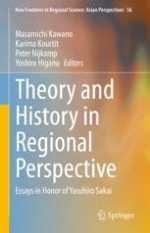2022 | OriginalPaper | Chapter
8. Dynamic Model of Urbanization with Public Goods
Author : Masamichi Kawano
Published in: Theory and History in Regional Perspective
Publisher: Springer Nature Singapore
Activate our intelligent search to find suitable subject content or patents.
Select sections of text to find matching patents with Artificial Intelligence. powered by
Select sections of text to find additional relevant content using AI-assisted search. powered by
